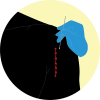The pencil eraser swab technique to quantify Cutibacterium acnes on shoulder skin
- PMID: 35024297
- PMCID: PMC8738962
- DOI: 10.5194/jbji-6-451-2021
The pencil eraser swab technique to quantify Cutibacterium acnes on shoulder skin
Abstract
Introduction: Cutibacterium acnes is the most common cause of postoperative infections in orthopaedic shoulder surgery and is hard to eradicate with current measures. Newer strategies focus on reducing bacterial load on the skin before surgery. Several previous studies have used a large number of both described and undescribed sampling techniques. The purpose of this study was to compare three previously described swab techniques to obtain bacterial cultures: Levine's (L) technique, the Z technique and the pencil eraser swab (PES) technique. Methods: Three consecutive skin swabs were collected from the right shoulder, on 15 healthy male volunteers, using Levine's technique, Z technique and PES technique from each participant. To determine the number of living bacteria, serial dilutions were made, and after culturing for 5 d, viable count (VC) was expressed as CFU/mL (with CFU representing colony-forming unit). Results: The PES technique yielded significantly higher VC than the two others. PES: median 3700 CFU/mL, L: 200 CFU/mL and Z: 220 CFU/mL ( ). There was no significant difference between the methods regarding the number of positive cultures. PES: 14/15, L: 11/15 and Z: 12/15. Conclusions: There is a need to harmonise sampling techniques of C. acnes in order to compare the efficacy of different measures to reduce the bacterial load on the skin before and during surgery. Of the three tested methods, the PES technique is simple and produces the highest bacterial counts.
Copyright: © 2021 Vendela M. Scheer et al.
Conflict of interest statement
The contact author has declared that neither they nor their co-authors have any competing interests.
Figures



